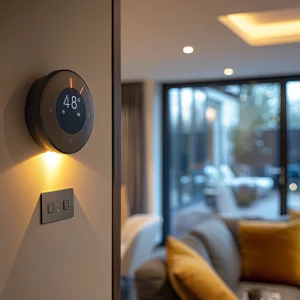
In the contemporary landscape of UK household management, the intersection of technology and utility savings represents a pivotal area of interest for homeowners and property owners alike. The surge in smart home devices has opened avenues for enhanced convenience and security and substantial savings on utility bills.
This exploration focuses on various smart home technologies that reduce energy consumption, streamline utility management, and foster an environmentally friendly lifestyle. The devices span multiple aspects of home utilities, including heating, lighting, water, and appliance management, promising economic and ecological benefits.
Smart Thermostats

At the forefront of this technological revolution are smart thermostats, epitomising the blend of convenience and conservation. They offer adaptive climate control features, allowing homeowners to fine-tune their heating and cooling systems for optimal comfort and efficiency. With the ability to learn from your habits, these thermostats adjust the temperature based on your schedule, presence, and even local weather conditions, ensuring energy is not wasted on an empty or unoccupied home. Integrating remote control capabilities further enhances their appeal, allowing temperature adjustments from any location, thereby avoiding unnecessary energy consumption.
The statistical potential for savings with smart thermostats is compelling. By maintaining your home’s temperature a mere one °C lower than usual, significant energy savings can be achieved. Research and real-world applications have shown that implementing a smart thermostat can lead to a reduction in heating costs by 10-12% and cooling costs by up to 15%. These devices also provide maintenance reminders and are compatible with systems like Hive, making them a versatile tool in the energy-saving arsenal of any homeowner.
Thermostatic Radiator Valves (TRVs) and Individual Room Control
Further refining the control over home heating systems are Thermostatic Radiator Valves (TRVs). These devices offer the ability to manage the temperature on a room-by-room basis, thereby preventing the wasteful heating of unoccupied spaces. This granular level of control not only enhances comfort but also significantly improves heating efficiency across the property.
Illuminating Savings with Smart Lighting
Transitioning from heating to lighting, smart lighting systems represent another pillar of utility savings. By utilising energy-efficient LED technology, these systems consume significantly less power than traditional bulbs while offering longer lifespans. The integration of automated adjustments, such as motion or occupancy detection and schedule-based operation, ensures that lights are on only when needed. Furthermore, the capability to adjust ambience through an app and to integrate lighting systems with smart hubs and voice assistants underlines the seamless integration of smart lighting into the fabric of modern, energy-conscious homes.
Smart Plugs and Power Strips

An often-overlooked component of the smart home ecosystem is the smart plug and power strip. These devices offer real-time energy monitoring, allowing homeowners to identify and manage the standby power draw of their appliances. By enabling scheduling and remote control of electrical devices, smart plugs and power strips ensure that appliances are only operational when needed, thereby avoiding unnecessary energy consumption. Following the advice of organisations like the Energy Savings Trust regarding appliance management can further enhance the utility savings afforded by these smart devices.
The Role of Smart Appliances in Energy Efficiency
The evolution of smart technology has also permeated the realm of household appliances. Smart appliances, including washing machines, refrigerators, and coffee makers, are designed for energy-efficient operation. They provide users with consumption awareness and the ability to adjust settings for optimised load, leading to reduced utility costs and a lower environmental footprint. The interconnected energy management capabilities of these appliances allow for a cohesive approach to reducing energy consumption across the board.
Smart Meters and Energy Monitoring
A critical component of managing your UK home energy consumption is understanding it. Smart meters and dedicated energy monitoring systems provide homeowners with real-time insights into their energy use, offering a granular view of consumption patterns. These tools are invaluable for identifying areas where energy use can be optimised, allowing for more informed decisions that can lead to significant savings. By offering actionable insights, smart meters empower homeowners to make adjustments that can lead to substantial reductions in energy consumption and, consequently, utility bills.
Automating Efficiency with Smart Blinds and Ceiling Fans

The integration of smart blinds and ceiling fans into the home automation system offers a dual approach to enhancing energy efficiency. Smart blinds automate the capture and release of sunlight, contributing to the home’s insulation and reducing the need for heating or cooling. By optimising the amount of natural light and heat entering the home, smart blinds can significantly impact energy consumption. Similarly, smart ceiling fans work in synergy with thermostats to provide room temperature optimisation, further enhancing the efficiency of heating and cooling systems.
Smart Water Meter
Building on the capabilities of intelligent water controllers, smart water meters offer detailed monitoring of water consumption. These devices go beyond leak detection to provide insights into usage patterns, helping homeowners identify opportunities for savings. Enhanced detection capabilities ensure that any irregularities in water use are promptly addressed, preventing wastage and promoting conservation.
LED Bulbs
Among the simplest yet most effective changes a homeowner can make is replacing traditional bulbs with LED counterparts. The high efficiency and longer lifespan of LED bulbs lead to direct energy savings and a reduced need for frequent replacements. This switch not only contributes to lower electricity bills but also reduces the environmental impact associated with the production and disposal of traditional bulbs.
Future Directions in Smart Home Technology
Looking ahead, the future of smart home technology holds promise for even greater advances in energy efficiency and environmental sustainability. Innovations in artificial intelligence and machine learning can lead to smarter, more intuitive systems that anticipate and adapt to homeowners’ needs with even greater precision, reducing energy consumption to the bare minimum required. Additionally, the integration of renewable energy sources with smart home systems could revolutionise how we power our homes, making self-sufficient, zero-net-energy homes a common reality.